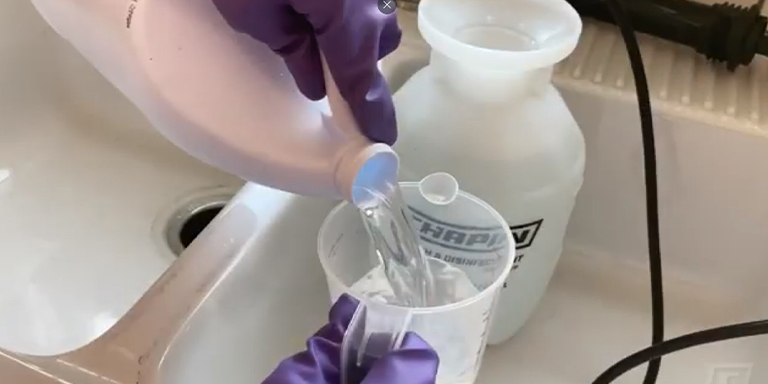Your cart is currently empty!
Using Your Sprayer for Disinfecting

Cleaning regularly is essential to keep viruses at bay. Here are some tips when using a sprayer for disinfection and sanitation.
DEEP CLEAN FIRST
Clean all surfaces and areas first to remove dirt, dust, and debris. It may seem counterintuitive, but this first step ensures maximum effectiveness of the disinfectant once applied. If you’re not using a specific bleach or industrial sprayer, you can use disinfectant mixtures but be aware of the composition of the sprayer seals as certain materials will degrade over time. Some seals are indicated as more chemically resistant than others.
CONSISTENT SPRAY
A consistent, controlled spray is one key to effective disinfecting. There should be no run off or waste of the solution. A Chapin hand pump or battery sprayer with an adjustable nozzle will give you the control you need, along with the length of the wand used. Complete and even coverage is important. Pay attention to how you hold the wand and spray back and forth evenly.
CHEMICAL SOLUTION
Sprayers offer different types of seals based on the application. Extreme seal materials hold up well with bleach and other caustic chemicals. Chapin offers specific sprayers made for bleach and strong chemicals. For example, the 20075 bleach sprayer and 61575 bleach backpack sprayer. If you have a basic sprayer, you’re still able to use household disinfectants. Follow the manufacturer mixing and cleaning instructions and remember to completely rinse out your sprayer after use to keep the seals in working order.

LARGE AREAS
Battery-operated or compressor-charged sprayers are ideal for larger areas. Chapin offers multiple battery backpack models, a battery-operated push sprayer, and compressor-charged tank sprayers. An adjustable nozzle allows not only even surface coverage, but the ability to switch to a coarse spray for removing extra dirt and debris.
ATV or UTV sprayers with a boom attachment are another alternative to a standard sprayer. Chapin’s Mixes on Exit sprayers allow you to keep the chemical concentrate and water separate so there’s no waste in material or cross-contamination of chemicals.
PERSONAL PROTECTION
As with any chemical or piece of equipment, please make sure you’re wearing the appropriate protective gear and following all manufacturer instructions. Chapin’s products come with instruction manuals or directions directly on the packaging. If you’re unsure, please refer to the manual or safety data sheets provided by the chemical manufacturer.
CDC: How to Properly Clean and Disinfect
Taken from the CDC website. Use this link for the full section on cleaning and disinfecting.
Hard (Non-porous) Surfaces
- If surfaces are dirty, they should be cleaned using a detergent or soap and water prior to disinfection.
- For disinfection, most common EPA-registered household disinfectants should be effective.
- Follow the manufacturer’s instructions for all cleaning and disinfection products for concentration, application method and contact time, etc.
- Additionally, diluted household bleach solutions (at least 1000ppm sodium hypochlorite) can be used if appropriate for the surface. Follow manufacturer’s instructions for application, ensuring a contact time of at least 1 minute, and allowing proper ventilation during and after application.
- Check to ensure the product is not past its expiration date.
- Never mix household bleach with ammonia or any other cleanser.
- Unexpired household bleach will be effective against coronaviruses when properly diluted.
Soft (Porous) Surfaces
- For soft (porous) surfaces such as carpeted floor, rugs, and drapes, remove visible contamination if present and clean with appropriate cleaners indicated for use on these surfaces.
- After cleaning:
- If the items can be laundered, launder items in accordance with the manufacturer’s instructions using the warmest appropriate water setting for the items and then dry items completely.
- Otherwise, use products that are EPA-approved for use against the virus that causes COVID-19 and that are suitable for porous surfaces
Prepare a bleach solution by mixing:
- 5 tablespoons (1/3 cup) bleach per gallon of water or
- 4 teaspoons bleach per quart of water